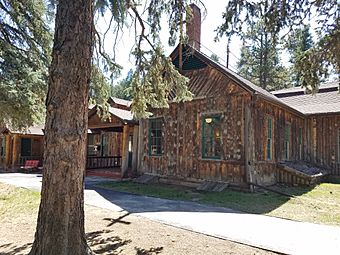Evergreen Conference District facts for kids
Quick facts for kids |
|
|
Evergreen Conference District
|
|

St. John's Episcopal Church in the Evergreen Conference District
|
|
| Lua error in Module:Location_map at line 420: attempt to index field 'wikibase' (a nil value). | |
| Location | CO 74, Evergreen, Colorado |
|---|---|
| Area | 7 acres (2.8 ha) |
| Architect | Jock Spence, et al. |
| Architectural style | Shingle Style |
| NRHP reference No. | 79000611 |
| Added to NRHP | May 1, 1979 |
The Evergreen Conference District is a special place in Jefferson County, Colorado, near the town of Evergreen. It's known as a historic district, which means it's an important place from the past. It was added to the National Register of Historic Places on May 1, 1979. You can find it along Highway 74, right next to Bear Creek.
Contents
What is the Evergreen Conference District?
This seven-acre center is a place where people gather. It is owned by the Evergreen Music Conference, the Sisters of St. Mary's, and the Episcopal Church of the Transfiguration. It is the oldest music center in the United States that has been running continuously since 1907.
The district has 23 buildings. Some of these include the Stone Library, the Meeting House, St. Raphael's, and the Bell Tower.
History Colorado says this district is important for several reasons:
- It shows what early 20th-century Evergreen looked like.
- It has special architectural features.
- It is connected to Canon Charles Winfield Douglas, an expert in plainsong music.
- It is linked to music, education, religion, and helping others.
The History of Evergreen Conference District
The land where the district is located was once hunting grounds for the Ute, Arapaho, and Cheyenne Native American tribes. Traders and fur trappers started passing through the area around 1821. Later, prospectors arrived during the Pike's Peak Gold Rush, which began in 1858.
In 1859, Bergen Park was founded when Thomas Cunningham Bergen built a log cabin there. The town of Evergreen became its own place in 1877. This happened when Amos Post opened a trading post and then a general store on what is now Evergreen's main street.
The name "Evergreen" came from D.P. Wilmot. Around 1875, he admired the fir, spruce, and pine trees on land he bought in Buffalo Park. Ranchers, loggers, and farmers settled along Bear Creek. People from cities also built summer homes in this beautiful mountain area.
Early Buildings and Retreats
In the 1880s, a log bunkhouse was built for lumbermen. Robert H. Stewart turned it into a hotel by 1872. He added eight small guest cottages and called his property Sprucedale Resort. The first church meetings in the area were held there in 1872.
Mary Neosho Williams, whose husband was Civil War General Thomas Williams, started a retreat center in 1893. She began holding Episcopal church services in tents. She bought the Stewart Hotel and changed it into St. Mark's in the Wilderness church. This church later became the Mission of the Transfiguration.
Her daughter, Dr. Josepha Williams, also bought land nearby. She received the former Stewart Hotel from her mother's will. Josepha then donated land and buildings to help create the conference center.
Music and Growth
Canon Charles Winfred Douglas, who was married to Josepha Williams, came to Evergreen for its summer retreats and music camps starting in 1897. He came for health reasons. He led many musical events, which made the center very popular. He was the priest of the retreat's church for over 40 years.
After Robert Stewart passed away, the Episcopal church bought the resort. They hired John "Jock" Spence to build more buildings and update some of the older ones. The family of Canon Charles Winfield Douglas and Mary Neosho Williams donated land and buildings to the district. In 1923, buildings from Frederick J. Bancroft's large 2,500-acre ranch were also given to the Evergreen Conference District.

